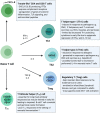Understanding Early-Life Adaptive Immunity to Guide Interventions for Pediatric Health
- PMID: 33552052
- PMCID: PMC7858666
- DOI: 10.3389/fimmu.2020.595297
Understanding Early-Life Adaptive Immunity to Guide Interventions for Pediatric Health
Abstract
Infants are capable of mounting adaptive immune responses, but their ability to develop long-lasting immunity is limited. Understanding the particularities of the neonatal adaptive immune system is therefore critical to guide the design of immune-based interventions, including vaccines, in early life. In this review, we present a thorough summary of T cell, B cell, and humoral immunity in early life and discuss infant adaptive immune responses to pathogens and vaccines. We focus on the differences between T and B cell responses in early life and adulthood, which hinder the generation of long-lasting adaptive immune responses in infancy. We discuss how knowledge of early life adaptive immunity can be applied when developing vaccine strategies for this unique period of immune development. In particular, we emphasize the use of novel vaccine adjuvants and optimization of infant vaccine schedules. We also propose integrating maternal and infant immunization strategies to ensure optimal neonatal protection through passive maternal antibody transfer while avoiding hindering infant vaccine responses. Our review highlights that the infant adaptive immune system is functionally distinct and uniquely regulated compared to later life and that these particularities should be considered when designing interventions to promote pediatric health.
Keywords: adaptive immunity; adjuvants; infant immunity; maternal antibody transfer; neonatal B cells; neonatal T cells; pediatric infectious diseases; vaccines.
Copyright © 2021 Semmes, Chen, Goswami, Burt, Permar and Fouda.
Conflict of interest statement
SP provides consulting services to Moderna, Merck and Co Vaccines, Pfizer Inc. and Sanofi for their preclinical CMV vaccine programs. The remaining authors declare that the research was conducted in the absence of any commercial or financial relationships that could be construed as a potential conflict of interest.
Figures


References
-
- Hug L, Alexander M, You D, Alkema L. UN Inter-agency Group for Child Mortality Estimation. National, regional, and global levels and trends in neonatal mortality between 1990 and 2017, with scenario-based projections to 2030: a systematic analysis. Lancet Glob Health (2019) 7(6):e710–20. 10.1016/S2214-109X(19)30163-9 - DOI - PMC - PubMed
-
- Levine OS, Bloom DE, Cherian T, De Quadros C, Sow S, Wecker J, et al. The future of immunisation policy, implementation, and financing. Lancet (2011) 378:439. 10.1016/S0140 www.thelancet.com. - DOI - PubMed
Publication types
MeSH terms
Grants and funding
LinkOut - more resources
Full Text Sources
Other Literature Sources

